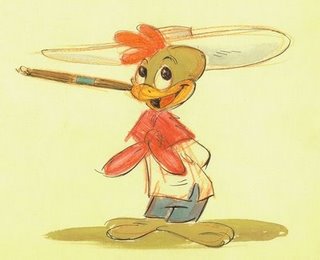
I believe that none of you will be surprised if I mention The Blackwing Diaries as one of the best sites on which to find Disney animation history these days, especially if you are a fan of Freddy Moore (and who isn't?) Jenny Lerew has been posting many drawings from the collection of James Walker and none of you could afford not to visit her blog.
The drawing above is one of those Jenny has been posting. You will not find others in the future here, as I have no intentition whatsoever of pirating Jenny's site. The little rooster, however, has an interesting story that I believe is worth mentioning and that historian JB Kaufman shared with me and Jenny a few weeks ago:
"There was supposed to be a third Latin American feature after Saludos Amigos and The Three Caballeros. The plans for it fluctuated quite a bit, as they did for the other two, but the title probably would have been Carnival, and it was definitely supposed to include a segment on Cuba. Fred Moore didn't go on the original South American trip in 1941, but he was part of the smaller group that went on a similar research trip to Cuba in September-October 1944. In planning the proposed Cuban film the studio tried to develop a character that would represent the country, in the same way that Joe Carioca represented Brazil and Panchito represented Mexico. Their tentative solution was a "guajiro" or "kikirigui" -- basically a fighting cock, but this was the popular name for a scrawny little bantam rooster, known for having a lot of attitude and not much of anything else. Moore was specifically assigned this character, and Norm Ferguson, the supervising producer, was counting on the inherent appeal of Moore's drawings to put the character over. The designs varied a lot and I'm not sure any final design was ever approved, but I think the drawings published by Jenny Lerew represent one phase of the character.
It's a long story, but basically the third Latin feature ran out of gas and was never finished. The Cuban segment was scrapped altogether, and some of the other ideas evolved at the Disney studio in surprising ways (Destino was one of them). The one segment to survive in something like its original form was Blame It on the Samba, which as you know was incorporated into Melody Time in 1948."
It is to be noted that JB wrote a book about the Disney Latin American films of the 40s, from the 1941 South American trip through the making of the films, which will hopefully be published soon.
Hello Didier!
ReplyDeleteYou, a pirate?! I think not! ; )
Seriously, please--I'm sure James Walker would be happy to have you & JB make such great use of these Moore images...isn't he lucky to been able to acquire them? And all together! I admit I'm envious, in a good way.
I was just thinking I must link to JB's excellent essay on this subject; I never followed it up as I'd meant to. I have also to link to you--it's very remiss of me not to have done it yet;. As you may have noticed I've not been able to update the blog as often recently--too much work(never a bad thing!)! As it is now it's 11pm Sunday night and I'm turning in...But look for a link and update about you soon. Thanks a million for doing this blog!
Thanks for the great plug this morning! I am always looking forward to reading new posts on your site, as you know. It's just a delight every morning.
ReplyDeleteWho is James Walker? Does he collect other artists' artwork aside from Moore's?